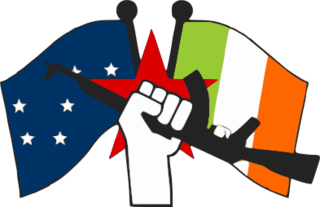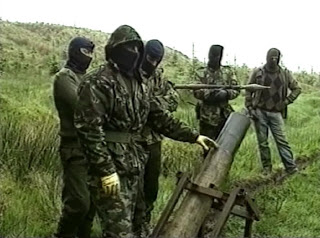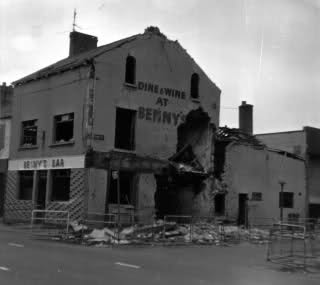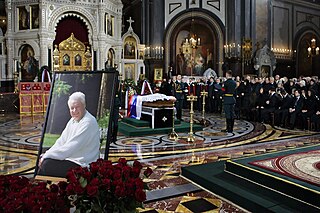Related Research Articles

The Continuity Irish Republican Army, styling itself as the Irish Republican Army, is an Irish republican paramilitary group that aims to bring about a united Ireland. It claims to be a direct continuation of the original Irish Republican Army and the national army of the Irish Republic that was proclaimed in 1916. It emerged from a split in the Provisional IRA in 1986 but did not become active until the Provisional IRA ceasefire of 1994. It is an illegal organisation in the Republic of Ireland and is designated a terrorist organisation in the United Kingdom, New Zealand and the United States. It has links with the political party Republican Sinn Féin (RSF).
The Real Irish Republican Army, or Real IRA (RIRA), was a dissident Irish republican paramilitary group that aimed to bring about a United Ireland. It formed in 1997 following a split in the Provisional IRA by dissident members, who rejected the IRA's ceasefire that year. Like the Provisional IRA before it, the Real IRA saw itself as the only rightful successor to the original Irish Republican Army and styled itself as simply "the Irish Republican Army" in English or Óglaigh na hÉireann in Irish. It was an illegal organisation in the Republic of Ireland and designated as a proscribed terrorist organisation in the United Kingdom and the United States.

The Irish National Liberation Army was an Irish republican socialist paramilitary group formed on 10 December 1974, during the 30-year period of conflict known as "the Troubles". The group seeks to remove Northern Ireland from the United Kingdom and create a socialist republic encompassing all of Ireland. With membership estimated at 80–100 at their peak, it is the paramilitary wing of the Irish Republican Socialist Party (IRSP).

The Ulster Volunteer Force (UVF) is an Ulster loyalist paramilitary group based in Northern Ireland. Formed in 1965, it first emerged in 1966. Its first leader was Gusty Spence, a former British Army soldier from Northern Ireland. The group undertook an armed campaign of almost thirty years during The Troubles. It declared a ceasefire in 1994 and officially ended its campaign in 2007, although some of its members have continued to engage in violence and criminal activities. The group is a proscribed organisation and is on the terrorist organisation list of the United Kingdom.

The Federal Security Service of the Russian Federation is the principal security agency of Russia and the main successor agency to the Soviet Union's KGB; its immediate predecessor was the Federal Counterintelligence Service (FSK) which was reorganized into the FSB in 1995. The three major structural successor components of the former KGB that remain administratively independent of the FSB are the Foreign Intelligence Service (SVR), the Federal Protective Service (FSO), and the Main Directorate of Special Programs of the President of the Russian Federation (GUSP).

The Russian apartment bombings were a series of explosions that hit four apartment blocks in the Russian cities of Buynaksk, Moscow, and Volgodonsk in September 1999, killing more than 300, injuring more than 1,000, and spreading a wave of fear across the country. The bombings, together with the Invasion of Dagestan, triggered the Second Chechen War. The handling of the crisis by Vladimir Putin, who was prime minister at the time, boosted his popularity greatly and helped him attain the presidency within a few months.

Spetsgruppa "A", also known as Alpha Group, or Alfa, whose official name is Directorate "A" of the FSB Special Purpose Center, is a stand-alone sub-unit of Russia's special forces within the Russian Federal Security Service (FSB). It was created by the Soviet KGB in 1974. Although little is known about the exact nature of its primary directives, it is speculated that the unit is authorised to act under the direct control and sanction of Russia's top political leadership, similar to its sister unit, the Directorate "V" (Vympel), which is officially tasked with protecting Russia's strategic installations, as well as conducting black operations inside and outside Russia. It is also available for extended police duties, for paramilitary operations, and for covert operations, both domestically and internationally.

The Kremlin Wall Necropolis is the former national cemetery of the Soviet Union, located in Red Square in Moscow beside the Kremlin Wall. Burials there began in November 1917, when 240 pro-Bolsheviks who died during the Moscow Bolshevik Uprising were buried in mass graves. The improvised burial site gradually transformed into the centerpiece of military and civilian honor during the Second World War. It is centered on Lenin's Mausoleum, initially built in wood in 1924 and rebuilt in granite in 1929–1930. After the last mass burial in Red Square in 1921, funerals there were usually conducted as state ceremonies and reserved as the final honor for highly venerated politicians, military leaders, cosmonauts, and scientists. In 1925–1927, burials in the ground were stopped; funerals were now conducted as burials of cremated ash in the Kremlin wall itself. Burials in the ground resumed with Mikhail Kalinin's funeral in 1946.
Michael Anthony Stone is a British ex-member of the Ulster Defence Association, a loyalist paramilitary group in Northern Ireland. He was convicted of three counts of murder committed at an IRA funeral in 1988. In 2000 he was released from prison on licence under the Good Friday Agreement. In November 2006, Stone was charged with attempted murder of Martin McGuinness and Gerry Adams, having been arrested attempting to enter the parliament buildings at Stormont while armed. He was subsequently convicted and sentenced in 2008 to a further 16 years' imprisonment, before being released on parole in 2021.

The Milltown Cemetery attack took place on 16 March 1988 at Milltown Cemetery in Belfast, Northern Ireland. During the large funeral of three Provisional IRA members killed in Gibraltar, an Ulster Defence Association (UDA) member, Michael Stone, attacked the mourners with hand grenades and pistols. He had learned there would be no police or armed IRA members at the cemetery. As Stone then ran towards the nearby motorway, a large crowd chased him and he continued shooting and throwing grenades. Some of the crowd caught Stone and beat him, but he was rescued by the police and arrested. Three people had been killed and more than 60 wounded. The "unprecedented, one-man attack" was filmed by television news crews and caused shock around the world.

From 1969 until 1997, the Provisional Irish Republican Army (IRA) conducted an armed paramilitary campaign primarily in Northern Ireland and England, aimed at ending British rule in Northern Ireland in order to create a united Ireland.

Saor Éire, also known as the Saor Éire Action Group, was an armed Irish republican organisation composed of Trotskyists and ex-IRA members. It took its name from a similar organisation of the 1930s.
Terrorism in Russia has a long history starting from the time of the Russian Empire. Terrorism, in the modern sense, means violence against civilians to achieve political or ideological objectives by creating extreme fear.

The Belfast Brigade of the Provisional IRA was the largest of the organisation's brigades, based in the city of Belfast, Northern Ireland.

The 1977 Moscow bombings were a series of three terrorist bombings in Moscow on 8 January 1977. The attacks killed seven people and seriously injured 37 others. No one claimed responsibility for the bombings, although three members of an Armenian nationalist organization were executed early in 1979 after a KGB investigation and a secret trial. Some Soviet dissidents said that the suspects had an alibi. Soon after the event Andrei Sakharov issued a public appeal, expressing concern that the bombings might "be a new provocation on the part of the organs of repression". According to historian Jay Bergman, "who actually caused the explosion has never been determined conclusively".

Richard Jameson, was a Northern Irish businessman and loyalist, who served as the leader of the paramilitary Ulster Volunteer Force's (UVF) Mid-Ulster Brigade. He was killed outside his Portadown home during a feud with the rival Loyalist Volunteer Force (LVF), the breakaway organisation founded by former Mid-Ulster UVF commander Billy Wright after he and the Portadown unit of the Mid-Ulster Brigade were officially stood down by the Brigade Staff in August 1996.

The Benny's Bar bombing was a paramilitary attack on 31 October 1972 in Belfast, Northern Ireland. A unit from the Ulster Freedom Fighters (UFF) of the Ulster Defence Association (UDA), a loyalist paramilitary group, detonated a no-warning car bomb outside the Irish Catholic-owned Benny's Bar in the dockland area of Sailortown, killing two young girls trick-or-treating in the area: Clare Hughes (4); and Paula Strong (6). Twelve of the pub's patrons were also injured in the explosion.

Jackie Coulter was a member of a loyalist paramilitary from Belfast, Northern Ireland who held the rank of lieutenant in the Ulster Defence Association (UDA). He was killed by the rival loyalist paramilitary organisation the Ulster Volunteer Force (UVF), as the result of a feud within loyalism.

Boris Yeltsin, the first President of Russia, died of cardiac arrest on 23 April 2007, twelve days after being admitted to the Central Clinical Hospital in Moscow. Yeltsin was the first Russian head of state to be buried in a church ceremony since Emperor Alexander III, 113 years prior.
References
- ↑ Pravda.Ru - Кровавая драма на Котляковском кладбище
- ↑ Michael Specter (November 11, 1996). "Cemetery Bomb In Moscow Kills 13 at Ceremony". New York Times. Retrieved March 3, 2012.